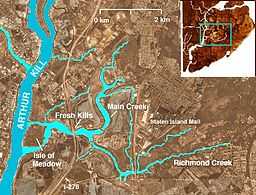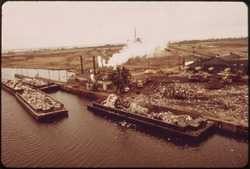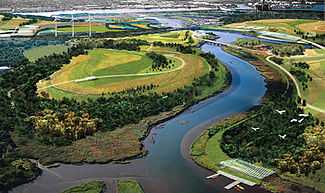Fresh Kills Landfill


The Fresh Kills Landfill was a landfill covering 2,200 acres (890 ha) in the New York City borough of Staten Island in the United States. The name comes from the landfill's location along the banks of the Fresh Kills estuary in western Staten Island.[1] The landfill was opened in 1947 as a temporary landfill but became New York City's principal landfill in the second half of the 20th century. It was once the largest landfill, as well as human-made structure, in the world.[2][3] In October 2008, reclamation of the site began on a multi-phase, 30-year site development for reuse as Freshkills Park.
History
Opening
The landfill opened in 1947 in what was then a rural agricultural area. The initial plan for a temporary landfill called for Fresh Kills to be used for 20 years, then developed as a multiuse area with residential, recreational, and industrial components.[4]
At the peak of its operation, the contents of twenty barges – each carrying 650 tons of garbage – were added to the site every day.[3] In 2001 it was estimated that, if kept open, the landfill would have eventually become the highest point on the East Coast.[3] Under local pressure and with support of the United States Environmental Protection Agency (EPA), the landfill site was closed on March 22, 2001, though it was temporarily reopened soon after for the September 11, 2001 attacks on the World Trade Center in Manhattan (see below).
Originally the land where the landfill was located was a salt marsh. The subsoil was made up of clay, with sand and silt as the top layer of soil. The land still contains large amounts of wildlife within the boundaries of the landfill. There were tidal wetlands, forests, and freshwater wetlands.[5]
1960s
Operations during the 1960s were conducted in three different locations named "Plant 1", "Plant 2", and "Brookfield Avenue." Plant #1 was located at the site of an old factory on the south side of junction of the Great Fresh Kills, and Little Fresh Kills. It was reachable via Muldoon Avenue. Plant #2 was located a bit upstream on the north side of Fresh Kills near where Richmond Creek branches off. It was reachable from Victory Boulevard. The Brookfield Avenue site, was north of the Arthur Kill Road and Brookfield Avenue intersection.

Plant 1 was the administrative headquarters, and also the main repair facility. Plant 1 and Plant 2 were marine unload operations. Barges arrived from the other boroughs (primarily Manhattan and Brooklyn). Garbage was picked up by a crane (called a "digger") using a clamshell bucket and deposited in a tracked side-dump vehicle called an "Athey wagon" (not related to equipment of the same name used for oil drilling). Two wagons were then pulled to the active dump site by tractor (Caterpillar D7, D8, D9) and emptied. The Plant 1 digger was electric but the Plant 2 one was steam powered. The diggers were supplemented by other cranes (mostly mounted on barges). A typical day would unload twelve barges (six at each plant). Operations were carried out from 8AM to midnight six days a week. The midnight to 8AM shift was for maintenance.
To expand the Plant 2 operating area, a wooden trestle bridge was built across Fresh Kills creek. This allowed dumping east to Richmond Avenue. As the actual dump site moved further from paved roads, it become more difficult for trucks to unload. The Brookfield Avenue site was opened in 1966 and used exclusively for trucks.
Original plans showed the dump with a twenty-year lifespan. One plan for a West Shore Expressway bridge across Fresh Kills included a tide gate, which would have blocked Plant 2's marine access. The bridge, when finally built in 1959, actually enhanced operations. The bridge was finished long before the rest of the expressway and was used by workers to travel between the two plants.
Animals were a problem. Feral dog packs roamed the dump and were a hazard to employees. Rats also posed a problem. Attempts to suppress the population with poison failed. The area was declared a wild bird sanctuary, and a number of hawks, falcons, and owls were brought in. The area became a popular spot for birdwatching. Because of the predatory birds, rat sightings, especially during the day, dropped dramatically.
September 11, 2001 and aftermath
After the September 11, 2001 attacks, Fresh Kills was temporarily used as a sorting ground for roughly one third of the rubble from Ground Zero. More than 1,600 personal effects were retrieved during this time. About two million tons of material obtained from Ground Zero was taken to the landfill for sorting.[6] Thousands of detectives and forensic evidence specialists worked for over 1.7 million hours at Fresh Kills Landfill to try to recover remnants of the people killed in the attacks. A final count of 4,257 human remains were recovered, but only 300 people were identified from these remains. A memorial is being built to honor those who were not able to be identified from the debris.[7] The remaining debris was buried in a 40-acre (160,000 m2) portion of the landfill; it is highly likely that this debris still contains fragmentary human remains.[8]
Fresh Kills Park Project

The Fresh Kills site is to be transformed into reclaimed wetlands, recreational facilities and landscaped public parkland, the largest expansion of the New York City parks since the development of the chain of parks in the Bronx during the 1890s. The new park will be designed by James Corner Field Operations, the landscape architecture firm also responsible for the design of the High Line in Manhattan. In January 2005, Staten Island Borough President James Molinaro announced plans to open three roads leading out of the former landfill to regular traffic, as part of an effort to ease the road congestion. Construction on the actual park began in 2008. The three-phase development of the park, which will include a September 11 memorial, is expected to last 30 years. The draft Environmental Impact Statement (EIS) was published for public review in May 2008. As of mid-2011, construction drawings for the first phase of development in the South Park section were being completed.[9]
The Department of Parks and Recreation are responsible for implementing the plan for turning the landfill into a park. They are using a Draft Master Plan which integrates three aspects, programming, wildlife, and circulation and proposes five main parks, the Confluence, North Park, South Park, East Park, and West Park.[10]
Fresh Kills Park will be three times the size of Central Park. It will consist of a variety of public spaces and facilities for a multitude of activity types. The site is large enough to support many sports and programs including nature trails, horseback riding, mountain biking, community events, outdoor dining, sports fields and canoeing.[11]
Staten Island Transfer Station
Staten Island Transfer Station occupies a small portion of the site of the former Fresh Kills Landfill near the old Plant #2 at 40°34′49″N 74°11′38″W / 40.580267°N 74.193994°W. The transfer station—an integral part of New York City's Solid Waste Management Plan—is expected to process an average of 900 tons per day of Staten Island-generated residential and municipal waste. The waste is compacted inside the 79,000-square-foot (7,300 m2) facility into sealed 12-foot-high (3.7 m) by 20-foot-long (6.1 m) intermodal shipping containers, which are then loaded, four containers each car, onto flatbed rail cars to be hauled by rail to a Republic Services landfill in South Carolina. The eight-mile (13 km) Staten Island Railway freight service, which connects the facility to the national rail freight network via the Arthur Kill Vertical Lift Bridge, was reactivated in April 2007, after it had been closed in 1991.[12]
See also
References
- ↑ "Fresh Kills T-shirt, ca. 1992". Online Collections Database. Staten Island Historical Society.
- ↑ "Fresh Kills Park Project Introduction". New York City Department of City Planning. 2007. Retrieved 2007-08-13.
- ↑ 3.0 3.1 3.2 John, Lloyd; Mitchinson, John (2006-10-05). QI: The Book of General Ignorance. Faber and Faber. pp. 114–115. ISBN 0-571-23368-6.
- ↑ Worldpress 1951 Report
- ↑ "Staten Island Landfill: Fresh Kills". Retrieved 2010-04-27.
- ↑ "Items from World Trade Center Recovery Operation, Fresh Kills Landfill". Online Collections Database. Staten Island Historical Society.
- ↑ "Recovery: The World Trade Center Recovery Operation at Fresh Kills". The New York State Museum. Retrieved 2010-04-27.
- ↑ Hartocollis, Anemona (24 March 2007). "Landfill Has 9/11 Remains, Medical Examiner Wrote". New York Times. Retrieved 26 November 2009.
- ↑ Freshkills Park Newsletter — Winter/Spring 2011
- ↑ "Fresh Kills Park". New York City Department of Parks and Recreation. Retrieved 2010-04-27.
- ↑ "Fresh Kills Park, New York City". Retrieved 2007-08-27.
- ↑ "Mayor Bloomberg officially reactivates the Staten Island railroad" (Press release). Government of New York City. April 17, 2007. Retrieved May 29, 2014.
External links
- Fresh Kills: New York City Department of Parks & Recreation information section
- Items in the Staten Island Historical Society Online Collection Database pertaining to Fresh Kills Landfill
Coordinates: 40°34′36″N 74°11′14″W / 40.57667°N 74.18733°W